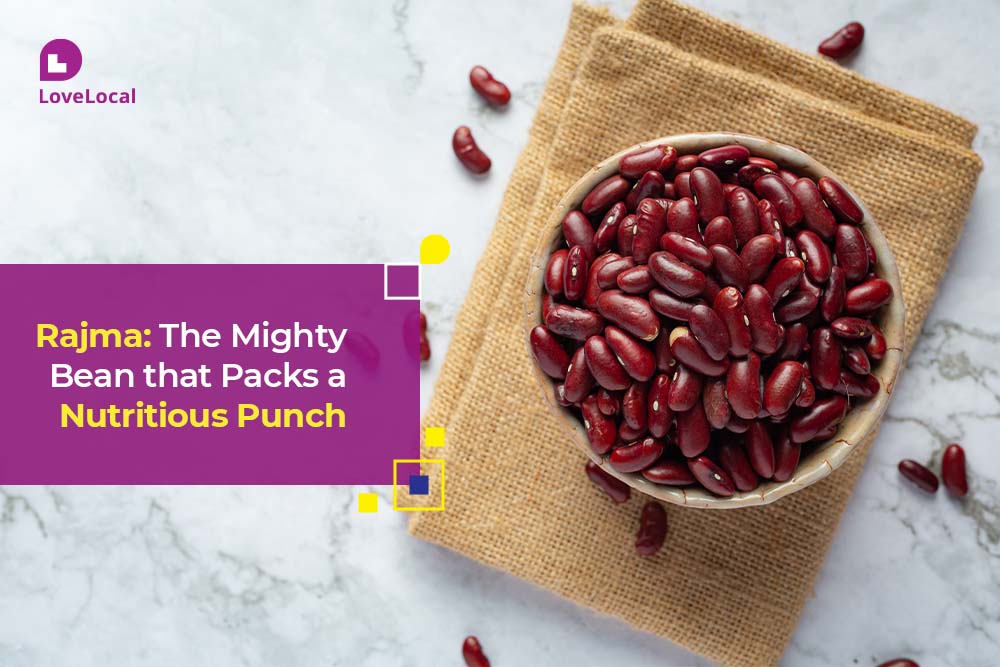Rajma, also known as red kidney beans, is a staple ingredient in Indian cuisine that has gained popularity all over the world. These kidney-shaped beans are rich in nutrients, delicious, and versatile, making them a favorite among vegetarians and non-vegetarians alike. From classic curries to salads and burgers, it can be used in a variety of dishes, and each preparation has its own unique flavor profile. In this blog, we will explore the many benefits of it, its nutritional value, and creative ways to incorporate it into our meals. Whether you are a fan of traditional Indian cuisine or looking to add more plant-based proteins to your diet, this blog will provide you with all the information you need to get the most out of this humble legume. So, let’s dive into the world of rajma and discover its wonders together!
Benefits of Rajma:
Here are some of the key benefits of red kidney bean:
- Rich in Protein: Red rajma is an excellent source of protein, with one cup of cooked beans providing around 15 grams of protein. This makes it an ideal food for vegetarians and vegans who may struggle to get enough protein from their diet.
- High in Fiber: White kidney bean is also a rich source of dietary fiber, with one cup of cooked beans providing around 13 grams of fiber. Fiber is essential for maintaining digestive health, promoting regular bowel movements, and reducing the risk of conditions like constipation, hemorrhoids, and colon cancer. This is one of the best White kidney beans benefits.
- Lowers Cholesterol Levels: Studies have shown that consuming kidney beans on a regular basis can help to lower LDL (bad) cholesterol levels in the blood, which can help to reduce the risk of heart disease.
- Stabilizes Blood Sugar: Rajma beans have a low glycemic index, which means that it releases sugar into the bloodstream slowly and steadily, helping to keep blood sugar levels stable. This makes it an ideal food for people with diabetes.
- Rich in Antioxidants: White kidney beans benefits include it being a rich source of antioxidants, which help to protect the body against free radical damage and reduce the risk of chronic diseases such as cancer, Alzheimer’s, and Parkinson’s.
- Boosts Energy: White kidney bean is a good source of complex carbohydrates, which provide sustained energy to the body. It also contains iron, which is essential for the production of red blood cells and can help to prevent anemia and fatigue.
In conclusion, kidney beans rajma is a highly nutritious food that offers a wide range of health benefits. Whether you are looking to improve your digestive health, reduce your risk of heart disease, or boost your energy levels, incorporating this into your diet can be a great way to achieve your health goals.
Creative Rajma dishes:
Today, we will explore the versatility of this humble ingredient and discover some creative ways to incorporate red kidney bean into our meals.
- Red Rajma Masala: The classic and most popular way to cook kidney beans is in a spicy tomato-based curry. The dish is usually served with rice or roti and garnished with coriander leaves. To make the dish more interesting, you can add some grated paneer or boiled eggs on top for extra protein.
- Rajma Salad: If you’re looking for a healthy and refreshing dish, try making a rajma salad. Simply mix boiled White kidney bean with chopped cucumber, onion, tomato, and coriander. Add a squeeze of lemon juice and some salt and pepper to taste. This salad can be served as a side dish or as a main course with some crusty bread.
- Rajma Burger: Who says burgers have to be made with meat? For a vegetarian twist, try making rajma burgers. Mash up boiled rajma beans with some bread crumbs, chopped onion, garlic, and spices of your choice. Form the mixture into patties and cook on a griddle until crispy. Serve on a bun with lettuce, tomato, and a dollop of yogurt sauce.
- Rajma Quesadillas: Give your Mexican meal a desi twist with red rajma quesadillas. Spread some mashed White kidney bean on a tortilla, sprinkle with grated cheese, and fold in half. Cook on a griddle until the cheese is melted and the tortilla is crispy. Serve with salsa and guacamole.
- Red Rajma Pizza: Yes, you read that right! Use red kidney bean as the base for your pizza instead of tomato sauce. Add your favorite toppings, such as sliced onions, bell peppers, mushrooms, and cheese. Bake in the oven until the crust is crispy and the cheese is melted.
In conclusion, it is a versatile ingredient that can be used in a variety of dishes. Whether you’re making a classic curry or trying something new, there are endless ways to enjoy this delicious legume. So go ahead, get creative, and let your taste buds explore the world of kidney beans rajma!
Side effects of Rajma:
While it is a highly nutritious and delicious legume, there are some potential side effects associated with its consumption. Here are some of the most common side effects of red kidney bean:
- Gas and Bloating: White rajma contains oligosaccharides, a type of carbohydrate that can be difficult to digest, leading to gas and bloating in some people. Soaking the beans overnight and boiling them thoroughly can help reduce this effect.
- Kidney Stones: Rajma beans contain a high amount of oxalates, which can increase the risk of developing kidney stones in some individuals. People with a history of kidney stones should limit their intake of this.
- Allergic Reactions: In rare cases, people may be allergic to red kidney bean, which can cause symptoms such as itching, swelling, and difficulty breathing. If you experience any of these symptoms after consuming it, seek medical attention immediately.
- Gastrointestinal Discomfort: Consuming red rajma in large amounts or undercooked can cause gastrointestinal discomfort, including nausea, vomiting, and diarrhea. Properly cooking the beans and limiting the portion size can help prevent these symptoms.
- Interference with Mineral Absorption: White rajma contains phytic acid, which can interfere with the absorption of certain minerals, such as iron, calcium, and zinc. Eating a variety of nutrient-rich foods can help mitigate this effect.
In conclusion, while kidney beans are generally safe for consumption and offer numerous health benefits, it is important to be mindful of the potential side effects associated with its consumption. If you experience any adverse reactions after consuming it, it is important to speak with your healthcare provider.
Conclusion:
Red kidney bean is a highly nutritious and versatile legume that offers a wide range of health benefits. It is a great source of protein, fiber, and antioxidants, making it an ideal food for people looking to maintain a healthy diet. These can be used in a variety of dishes, from classic curries to salads, burgers, and even pizza, providing endless possibilities for culinary creativity. Whether you are a vegetarian, vegan, or simply looking to add more plant-based proteins to your diet, incorporating rajma beans into your meals can be a great way to achieve your health goals while enjoying delicious food. So, the next time you’re in the mood for a nutritious and flavorful meal, don’t forget to reach for the rajma!



